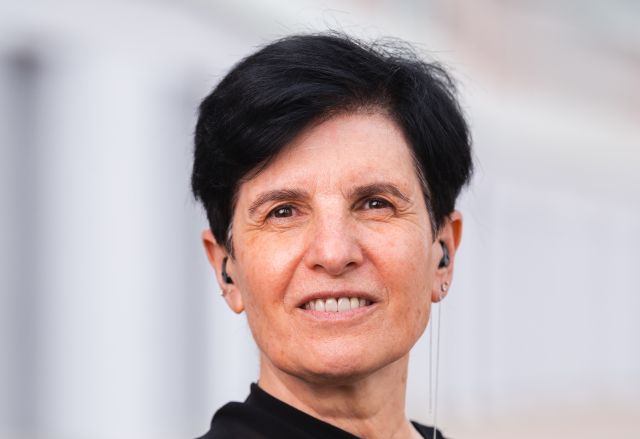Dorit Hanein Named Fellow of the American Society for Cell Biology
The UCSB professor is recognized for exceptional contributions to the field.

UC Santa Barbara professor Dorit Hanein, who holds joint appointments in the Department of Bioengineering and in the Department of Chemistry & Biochemistry, has been elected as a Fellow of the American Society for Cell Biology (ASCB). She is one of fourteen visionary scientists who received the prestigious honor in August, in recognition of their exceptional contributions to cell biology.
Fellows, according to the ASCB, “are selected by their peers and approved by the ASCB Council, celebrating a career of scientific excellence, leadership, and service to the cell biology community. These individuals have shaped the field through groundbreaking research, tireless mentorship, and commitment to advancing science.”
Hanein is an expert in cellular tomography, a technique that allows researchers to see the inside of a cell in three dimensions with remarkable detail. During her career, in addition to conducting research into cellular changes that can affect health, she has also established three state-of-the-art research facilities, most recently, the UCSB Structural Biology cryo-Electron Microscopy (SB2EM) facility.
“We are so proud of Professor Hanein and her most deserving recognition as a Fellow of the ASCB,” said Michelle O’Malley, interim chair of the Bioengineering Department and a professor of chemical engineering and bioengineering. “Dorit has been a fearless pioneer of cryogenic electron microscopy [cryo-EM] approaches throughout her distinguished career. We are so lucky to have her here at UCSB, where she is continuing to lead our new SB2EM facility and mentor the next generation of leaders who will decipher the inner workings of cells.”
“I am honored to receive this recognition,” Hanein said. “It reaffirms the importance of boundary-crossing research and inclusive mentorship. ASCB’s commitment to education, inclusion, and cell biological discovery mirrors my values as a scientist and mentor.”
Using powerful microscopes, Hanein studies how cells sense and respond to signals from their environment — specifically, how they convert mechanical signals into a biological response, a process known as mechanotransduction. These tasks are carried out by nanomachines, molecular assemblies that form on-demand inside cells. While most of the individual parts that make up these nanomachines are already known, how they come together and function inside living cells is still not fully understood. Hanein is closing this gap by developing innovative imaging platforms aimed at revealing changes in the architecture and behavior of these nanomachines while in their natural context, even under stress and stiffness. Such changes in their cellular environment can contribute to chronic inflammation, cancer progression, and age-related conditions such as neurodegenerative disease and chronic pain.
“Cryo-EM technologies offer a window into the inner architecture of cells, enabling us to ask and answer questions that were previously out of reach. The idea that we can use imaging to ‘see’ these processes in real time, at a molecular level, and link them to bigger questions in health, like cancer, tissue repair, or aging is incredibly exciting,” Hanein said. “By combining these techniques, we hope to uncover new insights into the biology of cancer and aging and help guide the development of treatments of conditions that affect millions of people worldwide.”
Hanein received her doctoral degree at the Weizmann Institute in Israel, where her PhD research led to a Science paper defining that cells sense the chirality of the underlying substrates at the onset of adhesion. As a Fulbright postdoctoral fellow at Brandeis University in Massachusetts, she worked with David DeRosier, one of the founders of three-dimensional image reconstruction techniques using electron microscopy. Early in her career, the Pew Charitable Trusts selected Hanein as a Pew Scholar in the Biomedical Sciences, an award that led to the characterization of the nanomachine that allows cells’ internal skeleton to generate forces to drive cell movement (Science). More recently, the Pew organization awarded her and Edward Chapman at the University of Wisconsin–Madison a Pew Innovation Fund grant to pursue interdisciplinary research on how proteins sculpt membranes. The process, which is closely linked to neurodegenerative disease, was published in Nature Structural and Molecular Biology.
In 2017, Hanein moved to Paris to become a distinguished professor at Institut Pasteur, where she expanded the toolkit of cellular tomography to allow incorporating dynamics, directly tying cell signaling to the onset of cell’s skeleton assembly (PNAS). At UCSB, where she arrived in 2022, Hanein develops approaches that integrate structural biology with engineering, materials science, and the physical sciences, drawing on the university’s collaborative and interdisciplinary atmosphere to study mechanotransduction in nanomachines within complex environments that more closely resemble their natural biological setting.
Hanein designed, built, and commissioned cryo-EM facilities at Institut Pasteur, at Sanford Burnham Prebys in La Jolla, where she served as a faculty member, and, most recently, at UCSB, where she is a faculty member and also serves as Scientific Director of the SB2EM cryo-EM facility. Alongside these efforts, she has launched training programs and symposia to ensure that advanced cryo-EM technologies are accessible to researchers and students, with a strong emphasis on mentoring and community.
“My goal has been to democratize cryo-EM by training the next generation of scientists, creating shared resources, and fostering a culture where discovery is supported by collaboration as much as by technology,” Hanein said.
Hanein will be recognized at the joint meeting of ASCB and the European Molecular Biology Organization, to be held in Philadelphia in December.